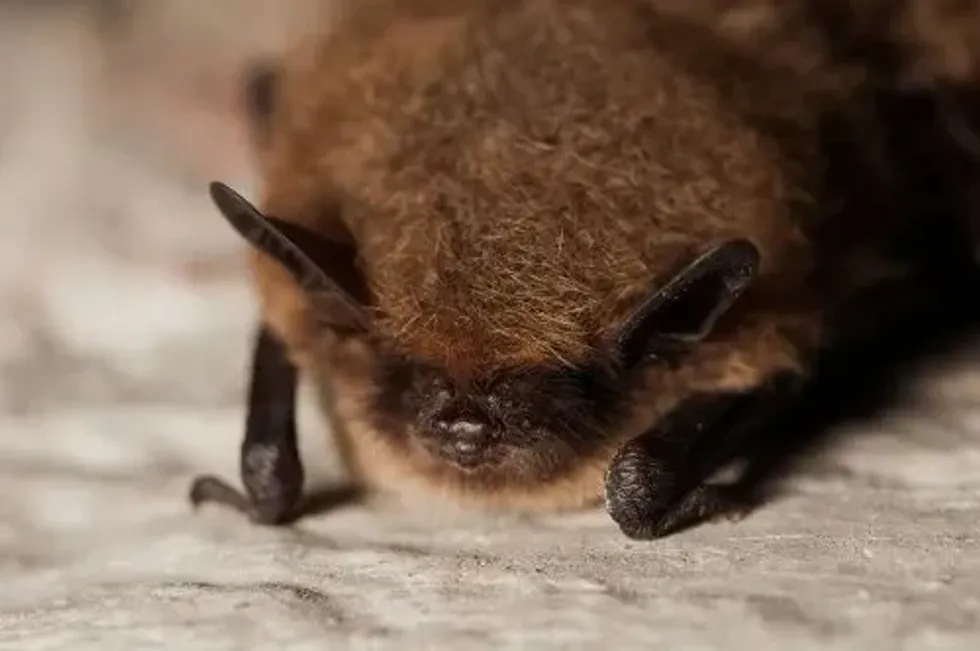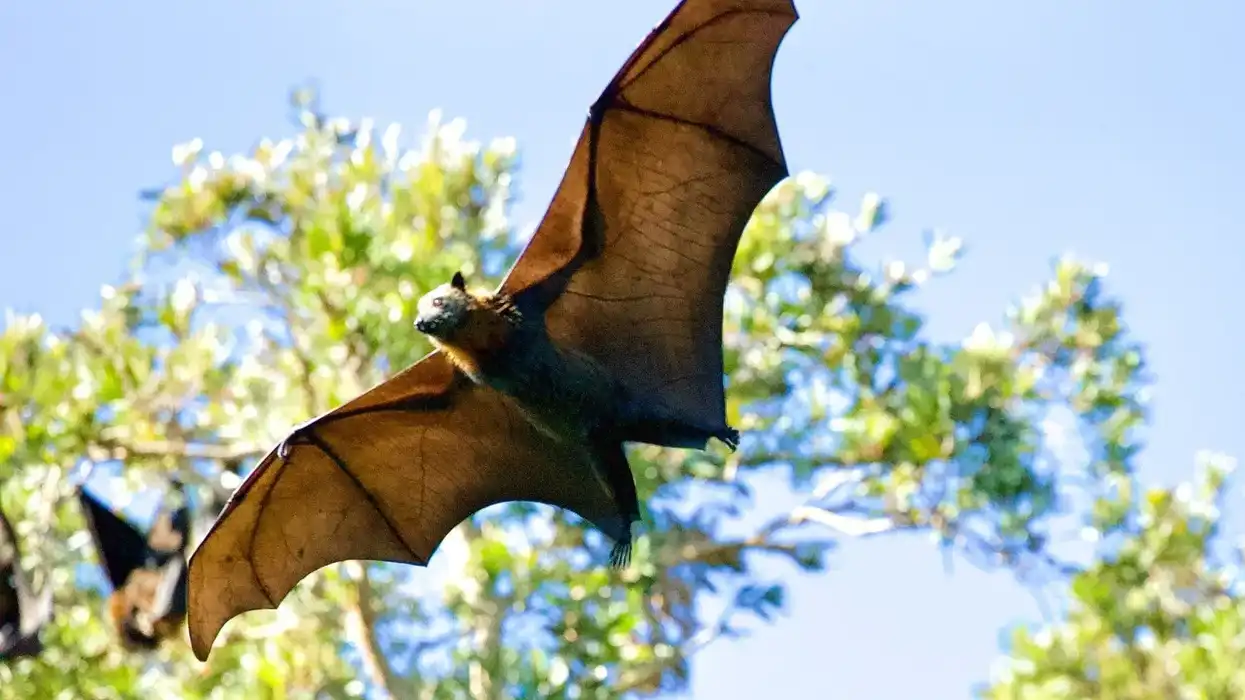There is a total of 1400 species of bats in the world. The whiskered bat, known by its scientific name Myotis mystacinus, belongs to the same family.
The whiskered bat (Myotis mystacinus) is seen in parks, towns, and gardens during summer in Europe and caves during winter. They are also seen down south in the Mediterranean. A whiskered bat (Myotis mystacinus) is more a house bat compared to a wild forest bat.
Whiskered bats are primarily carnivorous and feed on beetles, moths, and midges. Myotis mystacinus bats were often closely associated with the Brandt's bat. The Brandt's bat is also seen in Europe, however, the Brandt's bat and the whiskered bat are separate species.
Whiskered bats (Myotis mystacinus) are one of the smallest European bat species. They are classified as a Least Concern species by the International Union For Conservation Of Nature (IUCN). They are social beings and live in large groups.
For more relatable content, check out our fact files on the fruit bat and ghost bat.
Whiskered Bat Interesting Facts
What type of animal is a whiskered bat?
The whiskered bat is a type of bat that belongs to kingdom Animalia and the order Chiroptera.
What class of animal does a whiskered bat belong to?
Whiskered bats belong to class Mammalia, family Vespertilionidae, and genus Myotis.
How many whiskered bats are there in the world?
The whiskered bat's exact population number is not evaluated. They are classified as a Least Concern by the IUCN.
Where does a whiskered bat live?
Whiskered bats live in parks, towns, roosts, and gardens in the European range. Their number is mostly seen down south in the Mediterranean.
What is a whiskered bat's habitat?
A whiskered bat's habitats range constitutes parks, towns, roosts, and gardens during summer and caves during winter. However, one might associate bats with caves in forests. These bats are seen near urban habitats areas such as human settlements, although even in urban setups or roosts, they reside in a secluded region.
Who do whiskered bats live with?
Whiskered bats live as solitary beings as well as in groups. They reside in small groups during winters and also come together during the breeding season. They prefer to roost in warmer temperatures during winter compared to summer.
How long does a whiskered bat live?
The whiskered bat's average age is three years or more. However, some have been estimated to live up to 19 years of age or more.
How do they reproduce?
Males may mate with multiple females during the breeding season. Females attain maturity by one year and mating begins in the fall and continues until winter. They enter their winter roosts for hibernation.
Their gestation period may be variable since whiskered bats exhibit delayed implantation of the embryo whose development happened gradually. They build maternity colonies, usually in groups. The maternity colony is usually formed by females.
By mid-May to June, females give birth to one young and the females care for the young once they are born. Males are a little involved in raising their young by grooming, feeding, and protecting them at all times. By August, the roosts break apart and the young become independent.
What is their conservation status?
Whiskered bats are classified as a Least Concern species in the IUCN Red List of Threatened Species. They are not rare beings and are seen in quite abundantly in their habitats.
Whiskered Bat Fun Facts
What do whiskered bats look like?
Whiskered bats are the smallest bats in the world and they are often confused with the Brandt's bat. They have an overall dark fur over their body and are distinguished due to their whiskers located around their lips which act as a sensory organ as well.
The face and ears are dark brown and they have a long pointed ear. Their ears are complex and have four to five horizontal folds in the inner section. At the end of their body, they have a tail which is from 1.2- 1.7 in (30-43 mm).
Their upperparts are mostly dark, however, their underparts are lighter in color. Their wingspan is 7.5-8.7 in (190-220 mm).
How cute are they?
A whiskered bat is an extremely small and cute species. They are sociable beings, however, they are best observed from a distance. It is difficult to spot them during the day and much easier to spot them at night. They rest in their roost during the day and are active by night.
How do they communicate?
Bats primarily communicate using echolocation. These vocalizations or echolocation are used for locating food rather than for communication. The whiskered bat call is unique and distinct in its own right compared to other bat species. This bat species also utilizes tactile communication when they come into contact with other bats.
How big is a whiskered bat?
The whiskered bat species is 1.4-2 in (35-50 mm) in length, which is five times bigger than the Kitti's hog-nosed bat which is 1.1-1.3 in (29-33 mm) and the smallest bat in the world.
How fast can a whiskered bat move?
The whiskered bat's exact flight speed is not known. They are average in-flight speed and are similar to Brandt's bats in flight.
How much does a whiskered bat weigh?
The whiskered bat weighs 0.01 lb (5.3 g). They stay within their habitat range and consume a carnivorous diet.
What are the male and female names of the species?
Male and female bats are not addressed differently. They are similar in appearance, have more or less the same colored fur coat, and vary in reproductive functions.
What would you call a baby whiskered bat?
A baby whiskered bat is called a pup. The young pup is dependent on its parents in the initial few weeks until they fully develop. The juvenile is mostly brown in color.
What do they eat?
The whiskered bat diet is primarily carnivorous species. They feed on dung beetles, moths, velvet ants, midges, and other insects. Whiskered bats typically hunt over water bodies as well as forests and return to their home range or roosts on a daily basis.
Are they dangerous?
No, they are not dangerous and feed on insects. This species lives within their habitats. This bat species are sociable beings and live in semi-urban to urban areas during summer.
Would they make a good pet?
The whiskered bat species is ideally a wild species and it survives best in its natural habitat. They can be identified by their voice or their echolocation. In the United States, keeping bats as pets is illegal. The average bat lives in caves, however, this bat lives in urban to semi-urban areas of Europe and is easy to spot.
Did you know...
Echolocation is a means of communication through sound pulses. These bats use echolocation to track their prey as well. Echolocation enables them to hear voices and sounds that humans cannot perceive.
Out of the total nine species of bats in Ireland, the Leisler's bat is the largest bat species in Ireland and roosts in their habitat.
More than half the bat species in the United States are experiencing a severe decline and are not listed as endangered according to their current status.
Female bats can control the timing of their pregnancy as well as the birth of their baby bats. Female bats usually choose a time when food is available in abundance and they find an appropriate environment.
Can they harm you?
The whiskered bat, as well as other bats, are associated with diseases such as rabies. Some bats are also known to leave additional droppings called 'guano' which can contaminate the soil with fungus. It is best to keep a distance from bats as they may be transmitters of disease.
A virus called the NIPAH virus emerged as a result of fruit bats that fed on fruits infecting humans who touched or consumed them, causing severe illness as well as respiratory disease. Countries which this virus affected included Malaysia, Bangladesh as well as India and caused deaths among human populations.
It was curbed through proper treatments. The first time this occurred, however, was in a pig. There is still no cure and it's advised to wash fruits and vegetables thoroughly before consuming.
Do whiskered bats drink blood?
No, whiskered bats are not known to drink blood. There are only three species that solely feed on blood, including the common vampire bat, the hairy-legged vampire bat, and finally, the white-winged vampire bat.
Here at Kidadl, we have carefully created lots of interesting family-friendly animal facts for everyone to discover! For more relatable content, check out these pademelon facts and red kangaroo facts for kids.
You can even occupy yourself at home by coloring in one of our free printable whiskered bat coloring pages.









